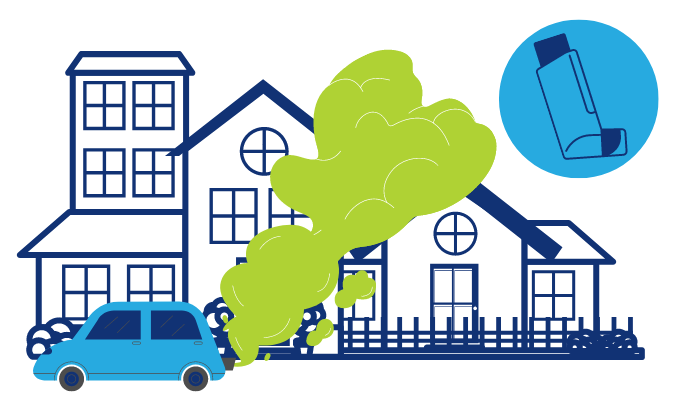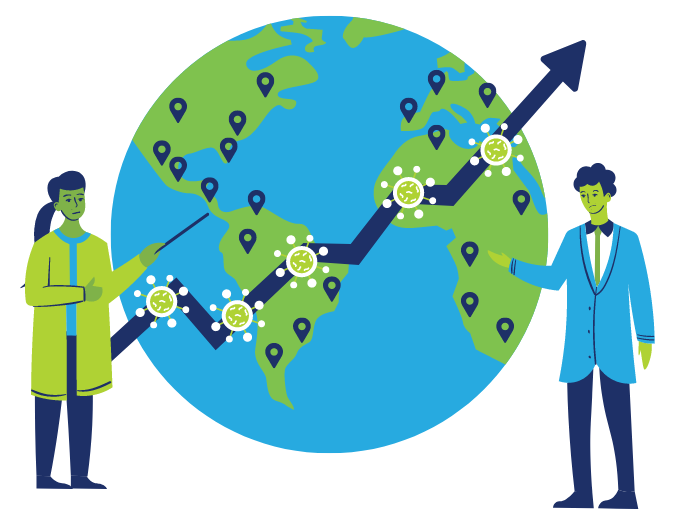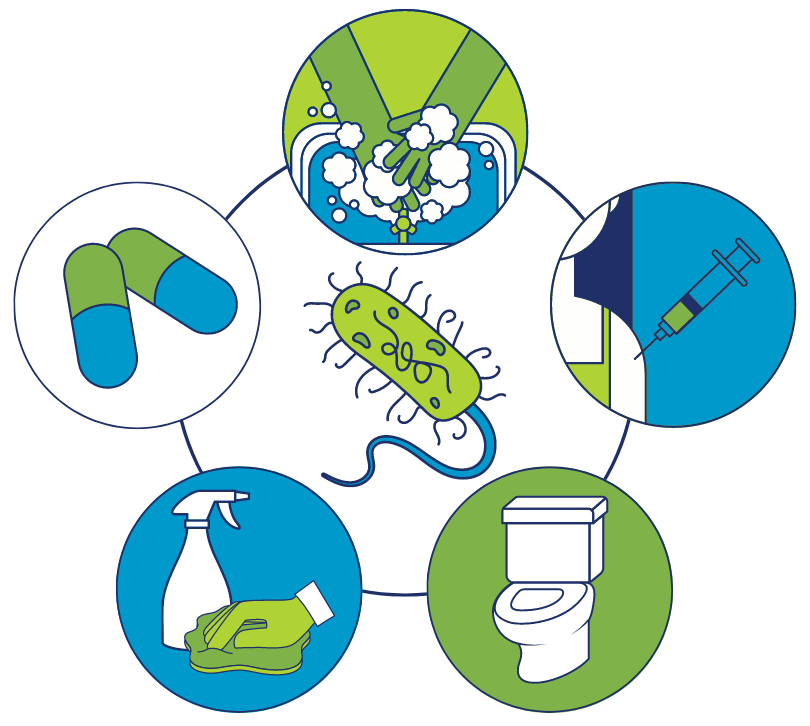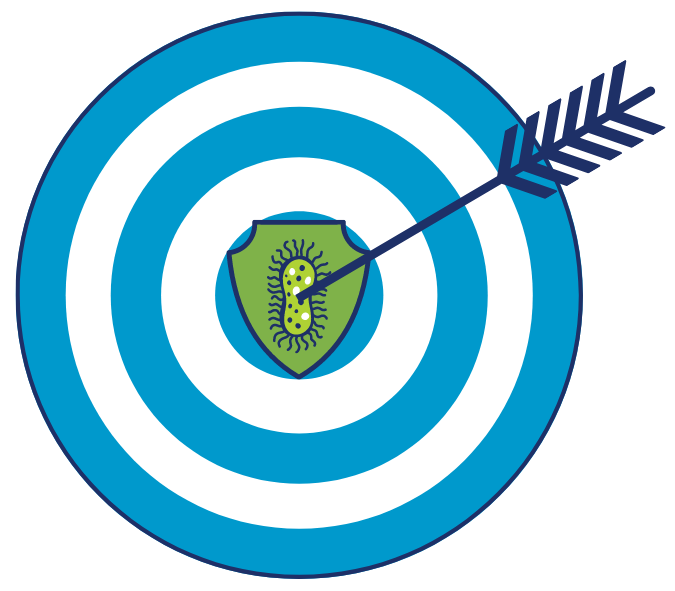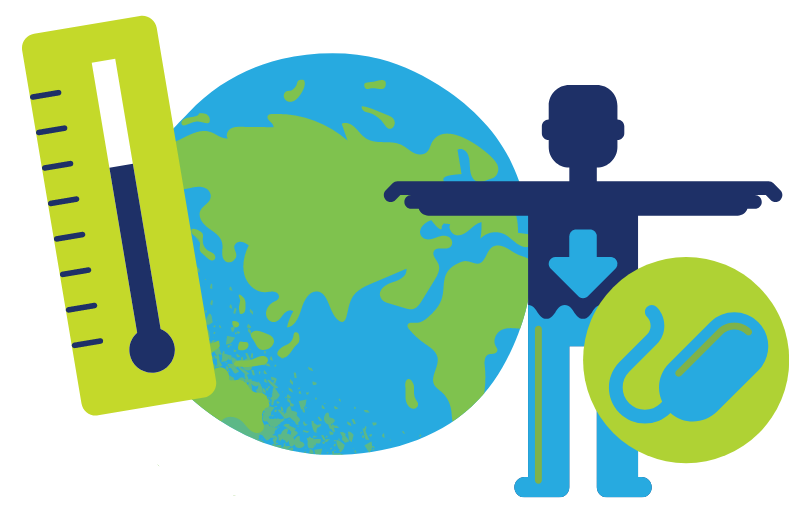
Few diseases are as fast-moving and horrific as cholera. Fiction may focus on the internal bleeding caused by Ebola, while movie scripts about zombie apocalypses pull from what’s known about rabies. But cholera can infect someone in the morning and kill them by the evening. It can take the life of a child before a parent can even register the little one is suffering from more than a run-of-the-mill tummy bug. Worse still, the diarrhea and vomiting caused by the infection carry the killer germs right back into the water supply that is its source.
Cholera never really goes away, but a recent upsurge has hit countries across the African continent from Malawi, Mozambique, and Zambia up to Ethiopia, Somalia, and Kenya. It’s infecting people in Pakistan, Lebanon, and Syria and is making a comeback in Haiti. A billion people are at risk, the World Health Organization says. Climate disasters and a weakening of public health resources are to blame.
Most measures used to strengthen public health, in general, can help fight cholera, says Amanda McClelland, senior vice president at Resolve to Save Lives.
In this episode of One World, One Health, listen as McClelland tells us about the gravity of the current multi-country outbreak of cholera. She explains that measures like clean water, good sanitation, vaccination, and access to basic healthcare can all help prevent cholera and stop ongoing outbreaks.
Maggie Fox 00:00
Hello and welcome to One World, One Health with the latest ideas to improve the health of our planet and its people. I’m Maggie Fox. All of us here on planet Earth are facing problems, such as pollution, climate change, and even infectious diseases (old and new). Animal health, human health, plant health, and the climate are all linked. This podcast is brought to you by the One Health Trust with bite-sized insights into ways to help.
People may be sick of COVID and may be arguing about whether the COVID pandemic is even actually over. But there is another ongoing pandemic that often flies under the radar because it’s been going on for so long now. It’s cholera. The current pandemic of cholera has been going on since 1961. And cases are on the rise again in many parts of the world. It’s partly because of COVID, which has stretched health resources globally. It’s also partially due to climate change because more frequent and more severe storms can create better conditions for the bacteria that cause cholera.
In this episode, we’re chatting with Amanda McClelland, Senior Vice President at Resolve to Save Lives. Amanda helps (to work) countries respond to and prevent pandemics and epidemics. Amanda, thanks so much for joining us.
Amanda McClelland 01:21
Thank you so much for having me.
Maggie Fox 01:23
You work to prevent epidemics. So, the world knows a lot about how to prevent cholera, but it’s popping up again everywhere. How can that be?
Amanda McClelland 01:33
You know, it’s surprising we think about cholera as one of those old diseases that that we’ve overcome. You know, back in the days in London, when John Snow first found the water sources in London, (and) whether they’re the cause of cholera. But we have more than 25 countries currently suffering an outbreak at the moment; it really is exploding. And it’s a combination of things.
I think, in part, fatigue coming out of COVID, (when) health systems were disrupted. Healthcare workers were very focused on COVID and cholera took the opportunity. We’re coming into a climate issue with the El Niño coming up this year, and the warmer waters and climate change are definitely driving a lot of the spread. And then we’ve really had a large number of natural disasters that really drive cholera and a number of conflicts. So, large cyclones in Mozambique, the earthquake in Turkey and northern Syria are among some of those.
Maggie Fox 02:25
And can we talk about where some of these recent outbreaks have been? You mentioned Mozambique and Turkey. Where else have we been seeing cholera come back?
Amanda McClelland 02:33
So, India is the most recent, just in the last few weeks, but we’re experiencing cholera in countries where we might not expect it, (such as) places like South Africa, as well as the Horn of Africa, the borders of Somalia, Ethiopia, Kenya, have been suffering a drought for a number of years now. And now with rain starting in the last few months, we’re seeing an explosion of cases.
So, it’s spread across a number of regions. But we’re really starting to see issues in parts of the Middle East and northern Syria, the Horn of Africa, and even in southern eastern Africa.
Maggie Fox 03:07
Now, clean water is a first step to preventing cholera spread. Why is it so difficult to manage this issue of clean water?
Amanda McClelland 03:16
Yeah, it’s one of those difficult questions in terms of we should be able to overcome this issue. Everyone deserves clean water. We have a number of ways to get clean water for people but there’s still millions of people around the globe that don’t have access to clean water every day. But what’s driving a lot of the cholera outbreak is those natural disasters that I mentioned. We’ve lost access in the earthquakes and the cyclones that contaminated the water.
The drought makes water sources more difficult to access. And so, it’s really about what access and water quality are really being impacted by climate change and a number of these large natural disasters.
Maggie Fox 03:53
It used to be common wisdom to say you can’t say this particular weather disaster is related to climate change. But can we start saying that now that climate change really is making these disasters more common?
Amanda McClelland 04:04
I’m not a climate scientist. But the regularity of these large-scale disasters and the consistency along with seasonality. We’re expecting El Niño, we know it’s a normal phenomenon. We’ve been through seven years of drought; we knew how to expect it. We know cholera is exacerbated by that cycle. But the warmer water temperatures is really what’s impacting cholera. And I think we can directly link that to climate change.
Maggie Fox 04:29
And let’s talk about that. There’s El Niño and the warmer waters. If, first of all, can we kind of break down what El Niño is and remind people what that is?
Amanda McClelland 04:38
It’s a shift in the climate cycles. So, in Africa where we focus mainly, especially for cholera, we’ve been through a period of seven, eight years of dry weather and now we’re expecting El Niño. It brings a lot more rain, increased temperatures, and drives a lot of disease patterns that we know about.
We know we get Rift Valley fever during El Niño; we know we get more cholera during El Niño. So, it’s this regular cycle that we see within the weather pattern, but it does change the environment, especially in the Horn of Africa, significantly.
Maggie Fox 05:11
And the Vibrio family of bacteria that cause cholera likes warmer water.
Amanda McClelland 05:16
It does. It grows much more quickly in warmer water. And it doesn’t mind saltwater, which is unusual. A little bit of salt in the water is okay for the Vibrio. And so, warmer sea temperatures and warmer temperatures on land, especially for water sources that have been impacted by drought, there’s less water perhaps in the dams or the lakes, the water temperature rises, not just because it’s hot, but because there’s less water inside those water sources. And then Vibrio cholerae expands and grows quite well in those conditions.
Maggie Fox 05:52
Now, cholera is often spread by people who don’t have any symptoms themselves. Can you talk a little bit about how that contributes to the problem?
Amanda McClelland 06:00
Yeah, it’s a big part of the problem. Only about one in ten people get that severe cholera that we perhaps know, which is that rice-water diarrhea, where it’s very obvious when you see clinically. People have a lot of vomiting and a lot of diarrhea. It’s very specific. But that only happens to one person in ten. Those other nine people potentially will have milder symptoms and might not even know they have cholera, or no symptoms at all. But those people are still shedding the bacteria in their feces. And so, that means they can still spread it unlike other diseases, where perhaps, you know, you can quarantine or isolate people with the disease.
(In) cholera, to some extent (due to) people knowing COVID, now we’ve started to learn more about asymptomatic transmission. It’s the same in cholera. So, even people that haven’t got severe symptoms are still able to spread the bacteria. And it remains in the environment for a prolonged period of time, which means you can contaminate water sources and spread the disease even if you’re not coming into close contact.
Maggie Fox 07:00
And let’s remind people again how cholera spreads. So it’s a systemic infection. And (then) the word is shedding. You shed it in your feces and especially, when you have diarrhea. Let’s talk a little bit more about that.
Amanda McClelland 07:11
You’re absolutely right. It’s a systemic disease, and it causes shedding in the bowels. Essentially, it draws the water from inside your bloodstream and the rest of your system into your bowel. And you get massive amounts of liquid feces. So, (you) essentially dehydrate very, very quickly, and (it) also causes vomiting.
So, the thing that makes cholera a little bit different is the absolute volume of diarrhea, and the decrease in electrolytes. So, you can go from being moderately unwell to being at risk of dying very, very quickly, even in a matter of hours.
Maggie Fox 07:45
And that’s the horrifying thing about cholera. People get sick and they’re dead by the end of the day, sometimes.
Amanda McClelland 07:51
Yeah, I’ve been in a number of cholera outbreaks, and it is very challenging to see people going from wildly unwell to essentially being in shock from not having enough fluid. It’s very easy to treat, which is also the challenging piece. If you can keep fluids going into people as quick as it’s coming out, you can save people’s lives. And that means, generally, just IV bags, but for most people, it means drinking what we call oral rehydration solutions. It’s like Gatorade without the color. Essentially, it’s sugary, salty water.
One of the challenges for the current outbreaks is that we don’t have enough supplies and the case fatality rate, the number of people dying with cholera is much higher than we would normally expect during these outbreaks. We’re seeing an average of 1.9% case fatality rate where we would normally see about 1 (percent) which is quite high and in parts of Africa, as high as 3%.
So not only do we have a lot more cholera than normal in a lot more countries, but the case fatality rate, the number of people it’s killing is much higher than normal as well.
Maggie Fox 08:52
And what about antibiotics? It’s a bacterial infection. Why not use antibiotics to treat people?
Amanda McClelland 08:56
Yeah, it’s really a difficult ——. There’s some resistance to antibiotics. The antibiotics do help decrease the amount of shedding that you mentioned, but it doesn’t necessarily cure cholera. So, it means that it doesn’t stop people spreading the bacteria into the environment.
Maggie Fox 09:13
Can vaccines help?
Amanda McClelland 09:14
Yes, there is a vaccine. It’s been on the market for some time, but we have limited supply globally. And it doesn’t help us necessarily stop outbreaks (once they’ve started) the way that we’ve perhaps used it in measles and other outbreaks. But it does definitely support protecting communities and stop what we call hotspots.
So, the vaccine is only about 60 to 70% effective. It’s not as good as something like the measles vaccine, but when we can give it to enough of the population in a high risk area, we have good evidence now that it stops outbreaks from starting and does help us slow the spread. So, they’re an important tool. But clean water, soap, and good hygiene remains the key tool.
Maggie Fox 09:57
And my understanding is (that) there’s some shortage of the vaccines now. There are three different vaccines but they’re not necessarily easily available.
Amanda McClelland 10:05
No, the supply chain has been a problem for some time. It’s not a vaccine that is highly marketable. And so, we haven’t had enough production across the globe. There’s been efforts by the global vaccine initiative and WHO to increase the number of manufacturers. But it remains a challenge. And at the moment, we still don’t have enough vaccine supply.
Maggie Fox 10:28
So, I think what you were saying, very tactfully there, if companies can’t make a lot of money selling these vaccines in rich countries, they don’t make enough of them to distribute in poorer countries.
Amanda McClelland 10:38
It’s a generalization. I’m sure that there’s other factors for sure. But we do see vaccines that aren’t necessarily widely distributed in the West and the North, always challenging in terms of manufacturing. And cholera is one of those vaccines, where the market is very focused on low-income countries, where cholera continues to spread.
Maggie Fox 10:59
What can we learn from the cholera response that can help us prepare better to fight other outbreaks?
Amanda McClelland 11:07
It’s a really good question. And I think from my experience, cholera is the perfect response to build capacity. You need all of the skills in terms of collaborating, good engagement with community, you need behavior change, you need to explain how cholera has spread, basic things like boiling water, or accessing safe water, using latrines, or washing hands are all things that can stop the outbreak, as well as good epidemiology and following the data. So, if you can get good at cholera outbreaks, it’s very transferable to other outbreaks.
And that’s one of the concerns at the moment, (as) we’re not able to get on top of these outbreaks for a number of different reasons. But it leaves capacity questions in terms of our ability to manage other outbreaks, (such as) why can’t we get on top of these outbreaks and (why are the case management, you know) why are so many people dying when the treatment protocol is well-known and fairly simple.
So, it’s really important that we use this opportunity to build our capacity back up, make sure that we have enough people trained across the —— in epidemiology, in their behavior change, communication, (and) case management. Build up that capacity again that’s been so depleted post-COVID not just to tackle these cholera outbreaks, but also to make sure that we’re better prepared for others.
Maggie Fox 12:22
So, what do you recommend that the world do to stop all of these cholera outbreaks from popping up?
Amanda McClelland 12:29
So, it needs a multipronged approach. I think (the) WHO has just called for more support, so there’s definitely a financing issue. The world is (also) fatigued after COVID. The lack of sustained funding to be able to tackle outbreaks, especially these types of outbreaks that can be isolated in poorer communities is really important.
So we need the right supplies (and) the right level of support for response. We need access to more vaccines, but also more access to supplies. We need to make sure that we’re following the data and getting all the way to the end. But we also need better prevention and preparedness. Many of these outbreaks have come on the back of natural disasters because health systems have been damaged because of flooding and challenges in clean and safe water.
So, it really is that holistic approach to making sure that people have access to basic services, even during natural disasters, and restrengthening the health system to be able to detect and respond quickly.
Maggie Fox 13:24
So sometimes, it helps to have a plan to fight some of these problems. Does Resolve to Save Lives have like a written plan for dealing with these issues?
Amanda McClelland 13:25
Most countries have a specific plan for cholera. But one of the things Resolve to Save Lives has been working on is how to improve the system to be able to detect and respond to cholera, but also to be ready for those other outbreaks.
So, we’ve been working on a project called the 7-1-7 Project. This is helping countries make sure they’re testing their system and they can find every outbreak in seven days, notify that disease in one day, and start rapid response within seven days. And this has been really important for a disease like cholera that spreads so quickly.
Maggie Fox 14:06
Amanda, thank you so much for joining us.
Amanda McClelland 14:09
Thank you so much.
Maggie Fox 14:11
If you liked this podcast, which is brought to you by the One Health Trust, please share it by email or on social media. And let us know what else you’d like to hear about at [email protected]. Thanks for listening.
Maggie Fox 00:00
Hola y bienvenido a One World, One Health con las últimas ideas para mejorar la salud de nuestro planeta y su gente. Soy Maggie Fox. Todos nosotros aquí en el planeta Tierra enfrentamos problemas, como la contaminación, el cambio climático e incluso enfermedades infecciosas (antiguas y nuevas). La salud animal, la salud humana, la sanidad vegetal y el clima están todos relacionados. Este podcast es presentado por One Health Trust con información breve sobre formas de ayudar.
Las personas pueden estar hartas de la COVID y pueden estar discutiendo sobre si la pandemia de la COVID realmente ha terminado. Pero hay otra pandemia en curso que a menudo pasa desapercibida porque ha estado ocurriendo durante mucho tiempo. Es el cólera. La actual pandemia de cólera se produce desde 1961. Y los casos están volviendo a aumentar en muchas partes del mundo. Se debe en parte a la COVID, que ha agotado los recursos sanitarios en todo el mundo. También se debe en parte al cambio climático porque tormentas más frecuentes y más severas pueden crear mejores condiciones para las bacterias que causan el cólera.
En este episodio, conversamos con Amanda McClelland, vicepresidenta sénior de Resolve to Save Lives. Amanda ayuda (a trabajar) a los países a responder y prevenir pandemias y epidemias. Amanda, muchas gracias por acompañarnos.
Amanda McClelland 01:21
Muchas gracias por invitarme.
Maggie Fox 01:23
Trabajas para prevenir epidemias. El mundo sabe mucho sobre cómo prevenir el cólera, pero está reapareciendo en todas partes. ¿Como puede ser?
Amanda McClelland 01:33
Sabes, es sorprendente que pensemos en el cólera como una de esas viejas enfermedades que hemos superado. Ya sabes, en los días en Londres, cuando John Snow encontró por primera vez las fuentes de agua en Londres, (y) si eran la causa del cólera, pero tenemos más de 25 países que actualmente sufren un brote; realmente está explotando. Y es una combinación de cosas.
Creo que, en parte, la fatiga derivada del COVID (cuando) los sistemas de salud se vieron afectados. Los trabajadores de la salud estaban muy concentrados en el COVID y el cólera aprovechó la oportunidad. Estamos entrando en un problema climático con la llegada de El Niño este año, y las aguas más cálidas y el cambio climático definitivamente están impulsando gran parte de la propagación. Y luego hemos tenido una gran cantidad de desastres naturales que realmente provocan el cólera y una serie de conflictos. Entre ellos se encuentran los grandes ciclones en Mozambique, el terremoto en Turquía y el norte de Siria.
Maggie Fox 02:25
¿Y podemos hablar de dónde han ocurrido algunos de estos brotes recientes? Mencionaste a Mozambique y Turquía. ¿Dónde más hemos visto regresar el cólera?
Amanda McClelland 02:33
India es el caso más reciente, apenas en las últimas semanas, pero estamos experimentando cólera en países donde no lo esperábamos, (como) lugares como Sudáfrica, así como el Cuerno de África, las fronteras de Somalia, Etiopía y Kenia sufren desde hace varios años una sequía. Y ahora, con las lluvias que han comenzado en los últimos meses, estamos viendo una explosión de casos.
Por lo tanto, se extiende por varias regiones. Pero realmente estamos empezando a ver problemas en partes de Medio Oriente y el norte de Siria, el Cuerno de África e incluso en el sur de África oriental.
Maggie Fox 03:07
Ahora, el agua potable es un primer paso para prevenir la propagación del cólera. ¿Por qué es tan difícil gestionar esta cuestión del agua potable?
Amanda McClelland 03:16
Sí, es una de esas preguntas difíciles en términos de si deberíamos poder superar este problema. Todo el mundo merece agua limpia. Tenemos varias formas de conseguir agua potable para la gente, pero todavía hay millones de personas en todo el mundo que no tienen acceso a agua potable todos los días. Pero lo que está impulsando gran parte del brote de cólera son los desastres naturales que mencioné. Hemos perdido el acceso por los terremotos y los ciclones que contaminaron el agua.
La sequía dificulta el acceso a las fuentes de agua. Por lo tanto, se trata realmente de qué acceso y calidad del agua se ven realmente afectados por el cambio climático y varios de estos grandes desastres naturales.
Maggie Fox 03:53
Solía ser de sabiduría común decir que no se puede decir que estos desastres naturales en particular estén relacionados con el cambio climático. Pero, ¿podemos empezar a decir eso ahora que el cambio climático realmente está haciendo que estos desastres sean más comunes?
Amanda McClelland 04:04
No soy un científico del clima. Pero la regularidad de estos desastres a gran escala y la coherencia van junto con la estacionalidad. Estamos esperando El Niño, sabemos que es un fenómeno normal. Hemos pasado por siete años de sequía; sabíamos cómo esperarlo. Sabemos que ese ciclo exacerba el cólera. Pero las temperaturas más cálidas del agua son realmente lo que está impactando el cólera. Y creo que podemos vincular eso directamente con el cambio climático.
Maggie Fox04:29
Y hablemos de eso. Hay El Niño en las aguas más cálidas. Si, en primer lugar, ¿podemos desglosar qué es El Niño y recordarle a la gente qué es?
Amanda McClelland 04:38
Es un cambio en los ciclos climáticos. Entonces, en África, donde nos concentramos principalmente, especialmente en el cólera, hemos pasado por un período de siete u ocho años de clima seco y ahora esperamos que El Niño traiga mucha más lluvia, aumente las temperaturas y conduzca mucho de patrones de enfermedades que conocemos.
Sabemos que nos da fiebre del Valle del Rift durante El Niño; Sabemos que tenemos más cólera durante El Niño. Entonces, es este ciclo regular el que vemos dentro del patrón climático, pero que cambia significativamente el medio ambiente, especialmente en el Cuerno de África.
Maggie Fox 05:11
Y a la familia Vibrio de bacterias que causan el cólera le gusta el agua más cálida.
Amanda McClelland 05:16
Lo hace. Crece mucho más rápidamente en aguas más cálidas. Y no le importa el agua salada, lo cual es inusual. Un poco de sal en el agua está bien para el Vibrio. Y así, temperaturas más cálidas en el mar y en la tierra, especialmente para las fuentes de agua que han sido afectadas por la sequía, hay menos agua tal vez en las represas o en los lagos, la temperatura del agua aumenta, no solo porque hace calor, sino porque hay menos agua. dentro de esas fuentes de agua. Y luego Vibrio cholera se expande y crece bastante bien en esas condiciones.
Maggie Fox 05:52
Ahora bien, el cólera suele ser transmitido por personas que no presentan ningún síntoma. ¿Puedes hablar un poco sobre cómo eso contribuye al problema?
Amanda McClelland 06:00
Sí, es una gran parte del problema. Sólo una de cada diez personas contrae ese cólera grave que tal vez conocemos, que es la diarrea de agua de arroz, que es muy evidente desde el punto de vista clínico. La gente tiene muchos vómitos y mucha diarrea. Es muy específico. Pero eso sólo le sucede a una persona de cada diez. Esas otras nueve personas potencialmente tendrán síntomas más leves y es posible que ni siquiera sepan que tienen cólera o que no tengan ningún síntoma. Pero esas personas todavía están eliminando las bacterias en sus heces. Y eso significa que aún pueden transmitirla a diferencia de otras enfermedades, donde quizás, ya sabes, se puede poner en cuarentena o aislar a las personas con la enfermedad.
(En) el cólera, hasta cierto punto (debido a) que las personas conocen el COVID, ahora hemos comenzado a aprender más sobre la transmisión asintomática. Lo mismo ocurre con el cólera. Por lo tanto, incluso las personas que no presentan síntomas graves pueden transmitir la bacteria. Y permanece en el medio ambiente durante un período prolongado de tiempo, lo que significa que puedes contaminar las fuentes de agua y propagar la enfermedad incluso si no estás en contacto cercano.
Maggie Fox 07:00
Y recordemos nuevamente a la gente cómo se propaga el cólera. Entonces es una infección sistémica. Y (entonces) la palabra se derrama, la arrojas en las heces y, sobre todo, cuando tienes diarrea. Hablemos un poco más sobre eso.
Amanda McClelland 07:11
Estás absolutamente en lo correcto. Es una enfermedad sistémica y provoca descamación en los intestinos. Básicamente, extrae el agua del interior del torrente sanguíneo y del resto del sistema hacia el intestino. Y obtienes cantidades masivas de heces líquidas. Entonces, esencialmente te deshidratas muy, muy rápidamente, y (eso) también causa vómitos.
Entonces, lo que hace que el cólera sea un poco diferente es el volumen absoluto de diarrea y la disminución de electrolitos. Así, puedes pasar de estar moderadamente enfermo a estar en riesgo de morir muy, muy rápidamente, incluso en cuestión de horas.
Maggie Fox 07:45
Y eso es lo horrible del cólera. La gente se enferma y, a veces, muere al final del día.
Amanda McClelland 07:51
Sí, he estado en varios brotes de cólera y es muy difícil ver a personas pasar de estar muy mal a estar esencialmente en shock por no tener suficiente líquido. Es muy fácil de tratar, lo cual también es un desafío. Si puedes hacer que los líquidos entren a las personas tan rápido como salen, puedes salvarles la vida. Y eso significa, generalmente, sólo bolsas intravenosas, pero para la mayoría de las personas significa beber lo que llamamos soluciones de rehidratación oral. Es como Gatorade sin color. Básicamente, es agua azucarada y salada.
Uno de los desafíos de los brotes actuales es que no tenemos suficientes suministros y la tasa de letalidad, el número de personas que mueren de cólera es mucho mayor de lo que normalmente esperaríamos durante estos brotes. Estamos viendo una tasa de letalidad promedio del 1,9%, donde normalmente veríamos alrededor del 1 (por ciento), que es bastante alto y en algunas partes de África, hasta el 3%.
Así que no sólo tenemos mucho más cólera de lo normal en muchos más países, sino que la tasa de letalidad y el número de personas que mata es mucho mayor de lo normal también.
Maggie Fox 08:52
¿Y qué pasa con los antibióticos? Es una infección bacteriana. ¿Por qué no utilizar antibióticos para tratar a las personas?
Amanda McClelland 08:56
Sí, es realmente difícil ——. Hay cierta resistencia a los antibióticos. Los antibióticos ayudan a disminuir la cantidad de derramamiento que mencionaste, pero no necesariamente curan el cólera. Entonces, significa que no impide que las personas propaguen la bacteria al medio ambiente.
Maggie Fox 09:13
¿Pueden ayudar las vacunas?
Amanda McClelland 09:14
Sí, hay una vacuna. Lleva algún tiempo en el mercado, pero tenemos una oferta limitada a nivel mundial. Y no necesariamente nos ayuda a detener los brotes (una vez que han comenzado) de la misma manera que quizás lo hemos usado en el sarampión y otros brotes. Pero definitivamente apoya la protección de las comunidades y detener lo que llamamos puntos críticos.
Por lo tanto, la vacuna tiene sólo entre un 60 y un 70% de eficacia. No es tan buena como la vacuna contra el sarampión, pero cuando podemos administrarla a una cantidad suficiente de población en un área de alto riesgo, ahora tenemos buena evidencia de que detiene el inicio de brotes y nos ayuda a frenar la propagación. Entonces, son una herramienta importante. Pero el agua limpia, el jabón y una buena higiene siguen siendo la herramienta clave.
Maggie Fox 09:57
Y tengo entendido que ahora hay cierta escasez de vacunas. Hay tres vacunas diferentes, pero no necesariamente están fácilmente disponibles.
Amanda McClelland 10:05
No, la cadena de suministro ha sido un problema desde hace algún tiempo. No es una vacuna altamente comercializable. Y por eso no hemos tenido suficiente producción en todo el mundo. La iniciativa mundial de vacunas y la OMS han realizado esfuerzos para aumentar el número de fabricantes. Pero sigue siendo un desafío. Y por el momento todavía no tenemos suficiente suministro de vacunas.
Maggie zorro 10:28
Entonces, creo que lo que usted estaba diciendo, con mucho tacto, es que, si las empresas no pueden ganar mucho dinero vendiendo estas vacunas en los países ricos, no fabrican suficientes vacunas para distribuirlas en los países más pobres.
Amanda McClelland 10:38
Es una generalización. Estoy segura de que hay otros factores. Pero sí vemos vacunas que no necesariamente se distribuyen ampliamente en Occidente y el Norte, y que siempre suponen un desafío en términos de fabricación. Y el cólera es una de esas vacunas cuyo mercado está muy centrado en los países de bajos ingresos, donde el cólera sigue propagándose.
Maggie Fox 10:59
¿Qué podemos aprender de la respuesta al cólera que pueda ayudarnos a prepararnos mejor para combatir otros brotes?
Amanda McClelland 11:07
Es una muy buena pregunta. Y creo que, según mi experiencia, el cólera es la respuesta perfecta para desarrollar capacidades. Necesita todas las habilidades en términos de colaboración, buen compromiso con la comunidad, necesita un cambio de comportamiento, necesita explicar cómo se ha propagado el cólera, cosas básicas como hervir agua o acceder a agua potable, usar letrinas o lavarse las manos son todas cosas. que puedan detener el brote, así como una buena epidemiología y seguimiento de los datos. Entonces, si puedes ser bueno en los brotes de cólera, es muy transferible a otros brotes.
Y esa es una de las preocupaciones en este momento, ya que no podemos controlar estos brotes por varias razones diferentes. Pero deja dudas en términos de nuestra capacidad para gestionar otros brotes, (como) por qué no podemos controlar estos brotes y (por qué la gestión de casos, ya sabes) por qué mueren tantas personas cuando el tratamiento, el protocolo es bien conocido y bastante simple.
Por lo tanto, es realmente importante que aprovechemos esta oportunidad para fortalecer nuestra capacidad y asegurarnos de que tengamos suficientes personas capacitadas en todo el mundo en epidemiología, en su cambio de comportamiento, comunicación y manejo de casos. Desarrollar nuevamente esa capacidad que se ha visto tan agotada después de la COVID, no solo para abordar estos brotes de cólera, sino también para asegurarnos de que estemos mejor preparados para otros.
Maggie Fox 12:22
Entonces, ¿qué recomienda que haga el mundo para evitar que surjan todos estos brotes de cólera?
Amanda McClelland 12:29
Por lo tanto, se necesita un enfoque múltiple. Creo que (la) OMS acaba de pedir más apoyo, por lo que definitivamente hay un problema de financiación. El mundo (también) está fatigado después del COVID. La falta de financiación sostenida para poder hacer frente a los brotes, especialmente este tipo de brotes que pueden aislarse en las comunidades más pobres, es realmente importante.
Por eso necesitamos los suministros adecuados (y) el nivel adecuado de apoyo para la respuesta. Necesitamos acceso a más vacunas, pero también más acceso a suministros. Necesitamos asegurarnos de seguir los datos y llegar hasta el final. Pero también necesitamos una mejor prevención y preparación. Muchos de estos brotes se han producido a raíz de desastres naturales porque los sistemas de salud han resultado dañados debido a las inundaciones y los problemas de agua limpia y segura.
Entonces, realmente se trata de ese enfoque holístico para garantizar que las personas tengan acceso a servicios básicos, incluso durante desastres naturales, y fortalecer el sistema de salud para que pueda detectar y responder rápidamente.
Maggie Fox 13:24
Por eso, a veces es útil tener un plan para combatir algunos de estos problemas. ¿Tiene Resolve to Save Lives un plan escrito para abordar estos problemas?
Amanda McClelland 13:25
La mayoría de los países tienen un plan específico para el cólera. Pero una de las cosas en las que ha estado trabajando Resolve to Save Lives es cómo mejorar el sistema para poder detectar y responder al cólera, pero también para estar preparado para esos otros brotes.
Hemos estado trabajando en un proyecto llamado Proyecto 7-1-7. Esto está ayudando a los países a asegurarse de que están probando su sistema y de que pueden encontrar cada brote en siete días, notificar esa enfermedad en un día e iniciar una respuesta rápida en siete días. Y esto ha sido realmente importante para una enfermedad como el cólera que se propaga tan rápidamente.
Maggie Fox 14:06
Amanda, muchas gracias por acompañarnos.
Amanda McClelland 14:09
Muchas gracias.
Maggie Fox 14:11
Si le gustó este podcast, presentado por One Health Trust, compártalo por correo electrónico o en las redes sociales. Y háganos saber qué más le gustaría saber en [email protected] . Gracias por su atención.
Guest
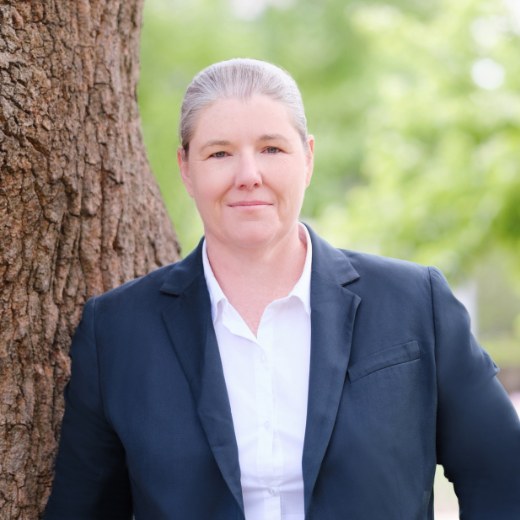
Amanda McClelland has more than 15 years of experience in international public health management. Amanda previously served as Global Emergency Health Advisor for the International Federation of Red Cross Red Crescent (IFRC) where she focused on emergency health, epidemic control, mass casualty in low-resource settings, disease prevention, and response operations.
Amanda earned her Master of Public Health and Tropical Medicine from James Cook University in Queensland, Australia, and her Bachelor of Nursing from Queensland University of Technology. In her capacity as Senior Vice President of the Prevent Epidemics (PE) Team at Resolve to Save Lives, Amanda leads the prioritization and planning of interventions/support in identified countries and regions to strengthen the action packages in prevention, detection, and response to epidemics.
Credits
Hosted and written by Maggie Fox
Special guest: Amanda McClelland
Produced and edited by Samantha Serrano
Music composed and sound edited by Raquel Krügel
Transcript edited by Dipyaman Sengupta

